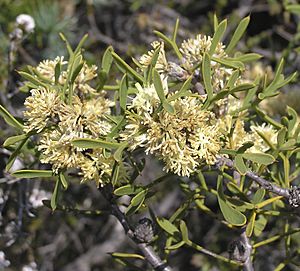Petrophile squamata facts for kids
Quick facts for kids Petrophile squamata |
|
|---|---|
 |
|
| In the Fitzgerald River National Park | |
| Scientific classification | |
| Genus: |
Petrophile
|
| Species: |
squamata
|
| Synonyms | |
|
List
|
|
Petrophile squamata is a species of flowering plant in the family Proteaceae and is endemic to southwestern Western Australia. It is a shrub usually with deeply divided, three-lobed and sharply-pointed leaves, and oval heads of hairy yellow or creamy-yellow flowers.
Description
Petrophile squamata is an erect shrub that typically grows to a height of 0.3–3 m (1 ft 0 in – 9 ft 10 in). The leaves are up to 65 mm (2.6 in) long on a petiole up to 28 mm (1.1 in) long, and deeply divided with three sharply-pointed lobes that often themselves have three to five lobes and are 3–35 mm (0.12–1.38 in) long. The flowers are arranged in leaf axils in sessile, oval heads 5–6 mm (0.20–0.24 in) long, with small deciduous involucral bracts at the base. The flowers are 8–10 mm (0.31–0.39 in) long, yellow or creamy-yellow and hairy. Flowering mainly occurs from July to December and the fruit is a nut, fused with others in a more or less oval head about 16 mm (0.63 in) long.
Taxonomy
Petrophile squamata was first formally described in 1810 by Robert Brown in Transactions of the Linnean Society of London. The specific epithet (squamata) means "scaly", referring to the involucral bracts.
Distribution and habitat
Petrophile squamata is a common and widespread species growing in sandy heath, shrubland or woodland between Perth and Israelite Bay.
Conservation status
This petrophile is classified as "not threatened" by the Western Australian Government Department of Parks and Wildlife.

